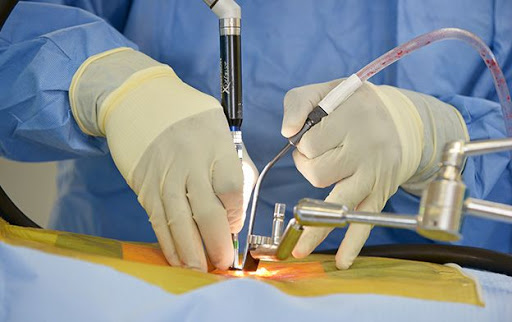(9am to 8pm)

MISS or Minimally Invasive Spine Surgery is a nominally intrusive procedure of surgery. It aims to cure conditions, respectively, within the spine of a human being. MISS uses small incisions instead of cutting 5 to 6 inches incision, which is how traditional spine surgery takes place. The technique of MISS focuses on the use of modern technology, progressive imaging methods, and distinct medical apparatus so that the tissue trauma, bleeding, radiation exposure are reduced. The hospital visits and revival of a being’s health are faster by abating the incision’s size.
Why MISS?
MISS or Minimally Invasive Spine Surgery can be made use of by treatment of various conditions such as Degenerative Disc Disease, Disc Herniation, Scoliosis, Spinal Stenosis, Fractures, Tumors, Infections, Instability and Deformity of the spine. This advanced procedure also paved the way for the treatment of the ailing members that were deemed to be high-risk for the traditional form of spine surgery due to their prior medical history or the circumstance’s complexity.
What are the goals with Spine Surgery?
It doesn’t matter if the spine surgery is achieved openly or Minimally Invasive Spine Surgery; there are two purposes for this procedure.
Decompression
Decompression of spine comprises of eradicating tissue which are constricting nerve structures. These structures include the Spinal Cord and Spinal Nerve Root. Bone fragments and spurs arise from a herniated disc are the specimens of tissue that give birth to neural compression.
Stabilization
Stabilization is the abnormal movement of one or more levels or sections of the spine that can give birth to back pain or neck pain. Surgical techniques like Spinal Instrumentation and Spinal Fusion soothe and stops the movement of the spine.
What is Traditional Spine Surgery?
Conventionally, spine surgery was accomplished by applying the “open surgery” method. This particular method necessitated the surgeons to create 5 to 6 inches of open-cut, i.e., incision along that specific portion of the spine. The surgeons would then pull back the tissue and muscles by making the use of surgical tools such as retractors to uncover the bone. This method of open surgery can affect more of the human anatomy and henceforth lead to lengthy periods for the recovery of the patient that was just operated upon.
How is MISS different than Open Surgery?
Minimally Invasive Spine Surgery or MISS overcomes the challenges posed by the traditional form of spine surgery- open surgery like trauma regarding the tissues and muscles, bleeding, and the peril of contaminations by reducing the incision’s size on the operated area. This also speeds up the therapy process of the human body.
What are the techniques of MISS?
How is MISS done?
An orthopedic surgeon performs Minimally Invasive Spine Surgery or MISS accompanied by a proficient medical team. Characteristically, they will begin the procedure by anesthetizing the specific part of a body along with sedation. They might also perform uncomplicated general anesthesia that will avert pain and permits the human being to snooze off throughout the surgery.
The next step is the surgeon will begin capturing fluoroscopic images on the affected section of the spine. This will allow them to perceive what they are operating on, in real-time, all the way through the surgery without producing a larger incision.
After this stage, the surgeon will commence the operation percutaneously by making an incision of 15 mm above the spine’s distressed portion. Then the surgeon has adequate space to permit the placing of a tubular retractor, which is a small, unyielding tube. This will allow the clinician to put small operating instruments into the spine along with endoscopic cameras and light.
After performing this procedure, the surgeon will make the essential fixes to the spine. The physician will extract concerned disc material through the tubular retractor and insert apparatuses like screws past the tubular retractor. Once the mends have been accomplished, the apparatuses and tubular retractors are removed from the person’s back.
In the end, the surgeon closes the incision using sutures, adhesive, or staples.
What are the benefits of MISS?
Minimally Invasive Spine Surgery or MISS offers abundant advantages. These advantages are-
What are the risks associated with MISS?
What are the problems regarding surgery?
Minimally Invasive Spine Surgery or MISS needs to be performed by a surgeon that is quite experienced in this field. Unlike traditional open surgery, the surgeons performing MISS must possess precision and wisdom about the usage of the different operating devices and MISS procedures to perform this operation precisely.
Another hazard that the patients face when the MISS or Minimally Invasive Spine Surgery is being performed upon them is the probability of damaged nerves. Due to the occurrence of the MISS incisions being small, the doctors can face a problem regarding noticing what area they are operating on. This, in turn, might cause the impairment of spinal nerves during the MISS procedure.
Radiation exposure is another peril that has been referred to during the procedure of the MISS taking place on the operating table. The application of fluoroscopic imagery during the method of MISS or Minimally Invasive Spine Surgery to see real-time images makes the usage of x-rays that permeate the skin of the patients. To add to this, the operating staff and doctors are exposed to the radiation.



